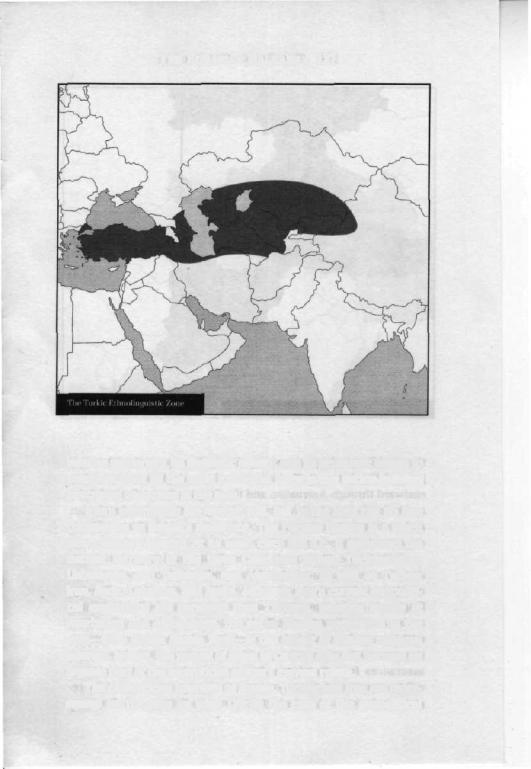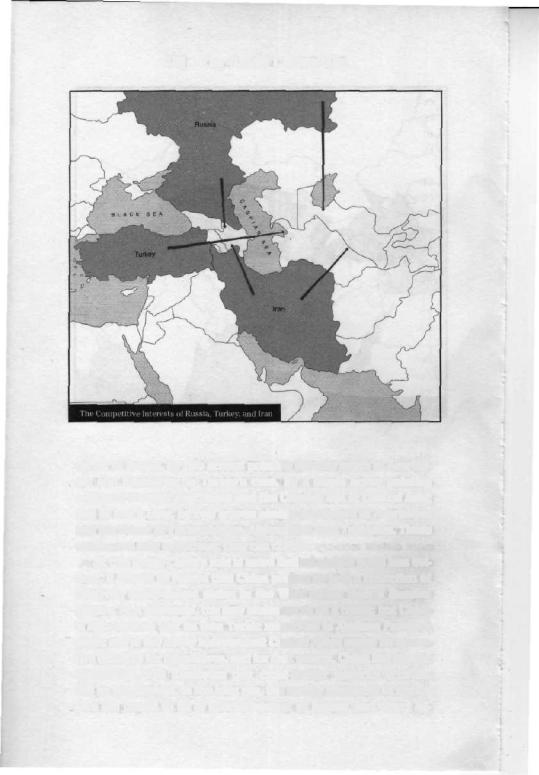
Grand_Chessboard
.pdf
THE EURASIAN BALKANS 133
political differences. Afghanistan thus has to be seen not only as a part of the Central Asian ethnic conundrum but also as politically very much part of the Eurasian Balkans.
Although all of the formerly Soviet Central Asian states, as well as Azerbaijan, are populated predominantly by Muslims, their political elites—still largely the products of the Soviet era—are almost uniformly nonreligious in outlook and the states are formally secular. However, as their populations shift from a primarily traditional clannish or tribal identity to a more modern national awareness, they are likely to become imbued with an intensifying Islamic consciousness. In fact, an Islamic revival—already abetted from the outside not only by Iran but also by Saudi Arabia—is likely to become the mobilizing impulse for the increasingly pervasive new nationalisms, determined to oppose any reintegration under Russ- ian—and hence infidel—control.
Indeed, the process of Isiamization is likely to prove contagious also to the Muslims who have remained within Russia proper. They number about 20 million—more than twice the number of disaffected Russians (circa 9.5 million) who continue to live under foreign rule in the independent Central Asian states. The Russian Muslims thus account for about 13 percent of Russia's population, and it is almost inevitable that they will become more assertive in claiming their rights to a distinctive religious and political identity. Even if that claim does not take the form of a quest for outright independence, as it has in Chechnya, it will overlap with the dilemmas that Russia, given its recent imperial involvement and the Russian minorities in the new states, will continue to face in Central Asia.
Gravely increasing the instability of the Eurasian Balkans and making the situation potentially much more explosive is the fact that two of the adjoining major nation-states, each with a historically imperial, cultural, religious, and economic interest in the re- gion—namely, Turkey and Iran—are themselves volatile in their geopolitical orientation and are internally potentially vulnerable. Were these two states to become destabilized, it is quite likely that the entire region would be plunged into massive disorder, with the ongoing ethnic and territorial conflicts spinning out of control and the region's already delicate balance of power severely disrupted. Accordingly, Turkey and Iran are not only important geostrategic

134 THE GRAND CHESSBOARD
players but are also geopolitical pivots, whose own internal condition is of critical importance to the fate of the region. Both are mid- dle-sized powers, with strong regional aspirations and a sense of their historical significance. Yet the future geopolitical orientation and even the national cohesion of both states remains uncertain.
Turkey, a postimperial state still in the process of redefining its identity, is pulled in three directions: the modernists would like to see it become a European state and thus look to the west; the Islamists lean in the direction of the Middle East and a Muslim community and thus look to the south; and the historically minded nationalists see in the Turkic peoples of the Caspian Sea basin and Central Asia a new mission for a regionally dominant Turkey and thus look eastward. Each of these perspectives posits a different strategic axis, and the clash between them introduces for the first time since the Kemalist revolution a measure of uncertainty regarding Turkey's regional role.
Moreover, Turkey itself could become at least a partial victim of the region's ethnic conflicts. Although its population of about 65 million is predominantly Turkish, with about 80 percent Turkic stock (though including a variety of Circassians, Albanians, Bosnians, Bulgarians, and Arabs), as much as 20 percent or perhaps even more are Kurdish. Concentrated in the country's eastern regions, the Turkish Kurds have increasingly been drawn into the struggle for national independence waged by the Iraqi and Iranian Kurds. Any internal tensions within Turkey regarding the country's overall direction would doubtless encourage the Kurds to press even more violently for a separate national status.
Iran's future orientation is even more problematic. The fundamentalist Shiite revolution that triumphed in the late 1970s may be entering its "Thermidorian" phase, and that heightens the uncertainty regarding Iran's geostrategic role. On the one hand, the collapse of the atheistic Soviet Union opened up Iran's newly independent northern neighbors to religious proselytizing but, on the other, Iran's hostility to the United States has inclined Teheran to adopt at least a tactically pro-Moscow orientation, reinforced by Iran's concerns regarding the impact on its own cohesion of Azerbaijan's new independence.
That concern is derived from Iran's vulnerability to ethnic tensions. Of the country's 65 million people (almost identical in num-

THE EURASIAN BALKANS 135
ber to Turkey's), only somewhat more than one-half are Persians. Roughly one-fourth are Azeri, and the remainder include Kurds, Baluchis, Turkmens, Arabs, and other tribes. Outside of the Kurds and the Azeris, the others at present do not have the capacity to threaten Iran's national integrity, especially given the high degree of national, even imperial, consciousness among the Persians. But that could change quite quickly, particularly in the event of a new political crisis in Iranian politics.
Furthermore, the very fact that several newly independent "stans" now exist in the area and that even the 1 million Chechens have been able to assert their political aspirations is bound to have an infectious effect on the Kurds as well as on all the other ethnic minorities in Iran. If Azerbaijan succeeds in stable political and economic development, the Iranian Azeris will probably become increasingly committed to the idea of a greater Azerbaijan. Thus, political instability and divisions in Teheran could expand into a challenge to the cohesion of the Iranian state, thereby dramatically extending the scope and increasing the stakes of what is involved in the Eurasian Balkans.
THE MULTIPLE CONTEST
The traditional Balkans of Europe involved head-on competition among three imperial rivals: the Ottoman Empire, the Austro-Hun- garian Empire, and the Russian Empire. There were also three indirect participants who were concerned that their European interests would be adversely affected by the victory of a particular protagonist: Germany feared Russian power, France opposed Austria-Hun- gary, and Great Britain preferred to see a weakening Ottoman Empire in control of the Dardanelles than the emergence of any one of the other major contestants in control of the Balkans. In the course of the nineteenth century, these powers managed to contain Balkan conflicts without prejudice to anyone's vital interests, but they failed to do so in 1914, with disastrous consequences for all.
Today's competition within the Eurasian Balkans also directly involves three neighboring powers: Russia, Turkey, and Iran, though China may eventually become a major protagonist as well. Also involved in the competition, but more remotely, are Ukraine,

136 THE GRAND CHESSBOARD
Pakistan, India, and the distant America. Each of the three principal and most directly engaged contestants is driven not only by the prospect of future geopolitical and economic benefits but also by strong historical impulses. Each was at one time or another either the politically or the culturally dominant power in the region. Each views the others with suspicion. Although head-on warfare among them is unlikely, the cumulative impact of their external rivalry could contribute to regional chaos.
In the case of the Russians, the attitude of hostility to the Turks verges on the obsessive. The Russian media portrays the Turks as bent on control over the region, as instigators of local resistance to Russia (with some justification in the case of Chechnya), and as threatening Russia's overall security to a degree that is altogether out of proportion to Turkey's actual capabilities. The Turks reciprocate in kind and view their role as that of liberators of their brethren from prolonged Russian oppression. The Turks and the Iranians (Persians) have also been historical rivals in the region, and that rivalry has in recent years been revived, with Turkey projecting the image of a modern and secular alternative to the Iranian concept of an Islamic society.
Although each of the three can be said to seek at least a sphere of influence, in the case of Russia, Moscow's ambitions have a much broader sweep because of the relatively fresh memories of imperial control, the presence in the area of several million Russians, and the Kremlin's desire to reinstate Russia as a major global power. Moscow's foreign policy statements have made it plain that it views the entire space of the former Soviet Union as a zone of the Kremlin's special geostrategic interest, from which outside political—and even economic—influence should be excluded.
In contrast, although Turkish aspirations for regional influence retain some vestiges of an imperial, albeit more dated, past (the Ottoman Empire reached its apogee in 1590 with the conquest of the Caucasus and Azerbaijan, though it did not include Central Asia), they tend to be more rooted in an ethnic-linguistic sense of identity with the Turkic peoples of the area (see map on page 137). Given Turkey's much more limited political and military power, a sphere of exclusive political influence is simply unattainable. Rather, Turkey sees itself as potential leader of a loose Turkicspeaking community, taking advantage to that end of its appealing

THE EURASIAN BALKANS 137
relative modernity, its linguistic affinity, and its economic means to establish itself as the most influential force in the nation-building processes underway in the area.
Iran's aspirations are vaguer still, but in the long run no less threatening to Russia's ambitions. The Persian Empire is a much more distant memory. At its peak, circa 500 B.C., it embraced the current territory of the three Caucasian states, Turkmenistan, Uzbekistan, and Tajikistan, and Afghanistan, as well as Turkey, Iraq, Syria, Lebanon, and Israel. Although Iran's current geopolitical aspirations are narrower than Turkey's, pointing mainly at Azerbaijan and Afghanistan, the entire Muslim population in the area—even within Russia itself—is the object of Iranian religious interest. Indeed, the revival of Islam in Central Asia has become an organic part of the aspirations of Iran's current rulers.
The competitive interests of Russia, Turkey, and Iran are represented on the map on page 138: in the case of the geopolitical

138 THE GRAND CHESSBOARD
thrust of Russia, by two arrows pointing directly south at Azerbaijan and Kazakstan; in Turkey's case, by a single arrow pointing eastward through Azerbaijan and the Caspian Sea at Central Asia; and in Iran's case, by two arrows aiming northward at Azerbaijan and northeast at Turkmenistan, Afghanistan, and Tajikistan. These arrows not only crisscross; they can collide.
At this stage, China's role is more limited and its goals less evident. It stands to reason that China prefers to face a collection of relatively independent states in the West rather than a Russian Empire. At a minimum, the new states serve as a buffer, but China is also anxious that its own Turkic minorities in Xinjiang Province might see in the newly independent Central Asian states an attractive example for themselves, and for that reason, China has sought assurances from Kazakstan that cross-border minority activism will be suppressed. In the long run, the energy resources of the region are bound to be of special interest to Beijing, and direct ac-

THE EURASIAN BALKANS 139
cess to them, not subject to Moscow's control, has to be China's central goal. Thus, the overall geopolitical interest of China tends to clash with Russia's quest for a dominant role and is complementary to Turkish and Iranian aspirations.
For Ukraine, the central issues are the future character of the CIS and freer access to energy sources, which would lessen Ukraine's dependence on Russia. In that regard, closer relations with Azerbaijan, Turkmenistan, and Uzbekistan have become important to Kiev, with Ukrainian support for the more independentminded states being an extension of Ukraine's efforts to enhance its own independence from Moscow. Accordingly, Ukraine has supported Georgia's efforts to become the westward route for Azeri oil exports. Ukraine has also collaborated with Turkey in order to weaken Russian influence in the Black Sea and has supported Turkish efforts to direct oil flows from Central Asia to Turkish terminals.
The involvement of Pakistan and India is more remote still, but neither is indifferent to what may be transpiring in these new Eurasian Balkans. For Pakistan, the primary interest is to gain geostrategic depth through political influence in Afghanistan—and to deny to Iran the exercise of such influence in Afghanistan and Tajikistan—and to benefit eventually from any pipeline construction linking Central Asia with the Arabian Sea. India, in reaction to Pakistan and possibly concerned about China's long-range influence in the region, views Iranian influence in Afghanistan and a greater Russian presence in the former Soviet space more favorably.
Although distant, the United States, with its stake in the maintenance of geopolitical pluralism in post-Soviet Eurasia, looms in the background as an increasingly important if indirect player, clearly interested not only in developing the region's resources but also in preventing Russia from exclusively dominating the region's geopolitical space. In so doing, America is not only pursuing its larger Eurasian geostrategic goals but is also representing its own growing economic interest, as well as that of Europe and the Far East, in gaining unlimited access to this hitherto closed area.
Thus, at stake in this conundrum are geopolitical power, access to potentially great wealth, the fulfillment of national and/or religious missions, and security. The particular focus of the contest, however, is on access. Until the collapse of the Soviet Union, access to the region was monopolized by Moscow. All rail transport,

140 THE GRAND CHESSBOARD
gas and oil pipelines, and even air travel were channeled through the center. Russian geopoliticians would prefer it to remain so, since they know that whoever either controls or dominates access to the region is the one most likely to win the geopolitical and economic prize.
It is this consideration that has made the pipeline issue so central to the future of the Caspian Sea basin and Central Asia. If the main pipelines to the region continue to pass through Russian territory to the Russian outlet on the Black Sea at Novorossiysk, the political consequences of this condition will make themselves felt, even without any overt Russian power plays. The region will remain a political dependency, with Moscow in a strong position to determine how the region's new wealth is to be shared. Conversely, if another pipeline crosses the Caspian Sea to Azerbaijan and thence to the Mediterranean through Turkey and if one more goes to the Arabian Sea through Afghanistan, no single power will have monopoly over access.
The troubling fact is that some elements in the Russian political elite act as if they prefer that the area's resources not be developed at all if Russia cannot have complete control over access. Let the wealth remain unexploited if the alternative is that foreign investment will lead to more direct presence by foreign economic, and thus also political, interests. That proprietary attitude is rooted in history, and it will take time and outside pressures before it changes.
The Tsarist expansion into the Caucasus and Central Asia occurred over a period of about three hundred years, but its recent end was shockingly abrupt. As the Ottoman Empire declined in vitality, the Russian Empire pushed southward, along the shores of the Caspian Sea toward Persia. It seized the Astrakhan khanate in 1556 and reached Persia by 1607. It conquered Crimea during 1774-1784, then took over the kingdom of Georgia in 1801 and overwhelmed the tribes astride the Caucasian mountain range (with the Chechens resisting with unique tenacity) during the second half of the 1800s, completing the takeover of Armenia by 1878.
The conquest of Central Asia was less a matter of overcoming a rival empire than of subjugating essentially isolated and quasitribal feudal khanates and emirates, capable of offering only sporadic and isolated resistance. Uzbekistan and Kazakstan were

THE EURASIAN BALKANS 141
taken over through a series of military expeditions during the years 1801-1881, with Turkmenistan crushed and incorporated in campaigns lasting from 1873 to 1886. However, by 1850, the conquest of most of Central Asia was essentially completed, though periodic outbreaks of local resistance occurred even during the Soviet era.
The collapse of the Soviet Union produced a dramatic historical reversal. In the course of merely a few weeks in December 1991, Russia's Asian space suddenly shrank by about 20 percent, and the population Russia controlled in Asia was cut from 75 million to about 30 million. In addition, another 18 million residents in the Caucasus were also detached from Russia. Making these reversals even more painful to the Russian political elite was the awareness that the economic potential of these areas was now being targeted by foreign interests with the financial means to invest in, develop, and exploit resources that until very recently were accessible to Russia alone.
Yet Russia faces a dilemma: it is too weak politically to seal off the region entirely from the outside and too poor financially to develop the area exclusively on its own. Moreover, sensible Russian leaders realize that the demographic explosion underway in the new states means that their failure to sustain economic growth will eventually create an explosive situation along Russia's entire southern frontier. Russia's experience in Afghanistan and Chechnya could be repeated along the entire borderline that stretches from the Black Sea to Mongolia, especially given the national and Islamic resurgence now underway among the previously subjugated peoples.
It follows that Russia must somehow find a way of accommodating to the new postimperial reality, as it seeks to contain the Turkish and Iranian presence, to prevent the gravitation of the new states toward its principal rivals, to discourage the formation of any truly independent Central Asian regional cooperation, and to limit American geopolitical influence in the newly sovereign capitals. The issue thus is no longer that of imperial restoration— which would be too costly and would be fiercely resisted—but instead involves creating a new web of relations that would constrain the new states and preserve Russia's dominant geopolitical and economic position.

142 THE GRAND CHESSBOARD
The chosen instrument for accomplishing that task has primarily been the CIS, though in some places the use of the Russian military and the skillful employment of Russian diplomacy to "divide and rule" has served the Kremlin's interests just as well. Moscow has used its leverage to seek from the new states the maximum degree of compliance to its vision of an increasingly integrated "commonwealth" and has pressed for a centrally directed system of control over the external borders of the CIS; for closer military integration, within the framework of a common foreign policy; and for the further expansion of the existing (originally Soviet) pipeline network, to the exclusion of any new ones that could skirt Russia. Russian strategic analyses have explicitly stated that Moscow views the area as its own special geopolitical space, even if it is no longer an integral part of its empire.
A clue to Russian geopolitical intentions is provided by the insistence with which the Kremlin has sought to retain a Russian military presence on the territories of the new states. Taking advantage of the Abkhazian secession movement, Moscow obtained basing rights in Georgia, legitimated its military presence on Armenian soil by exploiting Armenia's need for support in the war against Azerbaijan, and applied political and financial pressure to obtain Kazakstan's agreement to Russian bases; in addition, the civil war in Tajikistan made possible the continued presence there of the former Soviet army.
In defining its policy, Moscow has proceeded on the apparent expectation that its postimperial web of relationships with Central Asia will gradually emasculate the substance of the sovereignty of the individually weak new states and that it will place them in a subordinate relationship to the command center of the "integrated" CIS. To accomplish that goal, Russia is discouraging the new states from creating their own separate armies, from fostering the use of their distinctive languages (in which they are gradually replacing the Cyrillic alphabet with the Latin), from cultivating close ties with outsiders, and from developing new pipelines directly to outlets in the Arabian or Mediterranean Seas. If the policy succeeds, Russia could then dominate their foreign relations and determine revenue sharing.
In pursuing that goal, Russian spokesmen often invoke, as we have seen in chapter 4, the example of the European Union. In fact,
